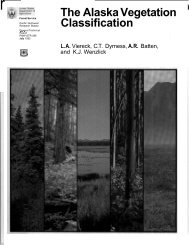Lectures on species interactions and competition
Lectures on species interactions and competition
Lectures on species interactions and competition
You also want an ePaper? Increase the reach of your titles
YUMPU automatically turns print PDFs into web optimized ePapers that Google loves.
Summary<br />
• Major types of competiti<strong>on</strong>: (1) interference competiti<strong>on</strong> (<strong>species</strong> directly interfere<br />
with each other, e.g. allelopathy), (2) exploitati<strong>on</strong> competiti<strong>on</strong> (mediated by<br />
exploitati<strong>on</strong> for a shared resource, most plant competiti<strong>on</strong> is of this type), (3)<br />
apparent competiti<strong>on</strong> (mediated through a third <strong>species</strong> such as an herbivore).<br />
• Regular or clumped distributi<strong>on</strong> patterns can be used to infer competiti<strong>on</strong> in some<br />
cases.<br />
• Gause s competitive exclusi<strong>on</strong> principle for animals <strong>and</strong> the Verhulst-Pearl equati<strong>on</strong>s<br />
can be applied to plants in modeling situati<strong>on</strong>s, but in the real world, plants often<br />
coexist because natural populati<strong>on</strong>s may not come into equilibrium very often, or<br />
other interacti<strong>on</strong>s may limit the full competitive interacti<strong>on</strong> between <strong>species</strong>.<br />
• Spatial <strong>and</strong> temporal variati<strong>on</strong> in resource availability allows for the coexistence of<br />
several <strong>species</strong>. This can be inferred using differences in dispersal abilities, or<br />
differences in above- <strong>and</strong> below-ground allocati<strong>on</strong>.<br />
• Tilman focused <strong>on</strong> resource competiti<strong>on</strong> as the basis for most competitive<br />
interacti<strong>on</strong>s. His resource-ratio models are based <strong>on</strong> <strong>species</strong> relative abilities to<br />
compete for resources.<br />
• Grime s models predict the str<strong>on</strong>gest competiti<strong>on</strong> in high resource envir<strong>on</strong>ments.<br />
Plants able to c<strong>on</strong>vert resources to high growth rates are the best competitors in<br />
these situati<strong>on</strong>s.<br />
• Allelopathy is an example of an amensal (0,-) interacti<strong>on</strong> (or interference competiti<strong>on</strong>).<br />
Many plants release allelochemicals that are inhibitory to the growth of other <strong>species</strong>.
















